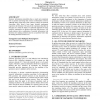153 search results - page 1 / 31 » Better Informed Training of Latent Syntactic Features |
EMNLP
2006
13 years 6 months ago
2006
We study unsupervised methods for learning refinements of the nonterminals in a treebank. Following Matsuzaki et al. (2005) and Prescher (2005), we may for example split NP withou...
EMNLP
2008
13 years 6 months ago
2008
We show that jointly parsing a bitext can substantially improve parse quality on both sides. In a maximum entropy bitext parsing model, we define a distribution over source trees,...
ICCV
2011
IEEE
12 years 5 months ago
2011
IEEE
We describe a directed bilinear model that learns higherorder groupings among features of natural images. The model represents images in terms of two sets of latent variables: one...
BMCBI
2008
13 years 5 months ago
2008
Background: Prediction of transmembrane (TM) helices by statistical methods suffers from lack of sufficient training data. Current best methods use hundreds or even thousands of f...
SIGIR
2003
ACM
13 years 10 months ago
2003
ACM
Syntactic information potentially plays a much more important role in question answering than it does in information retrieval. Although many people have used syntactic evidence i...

